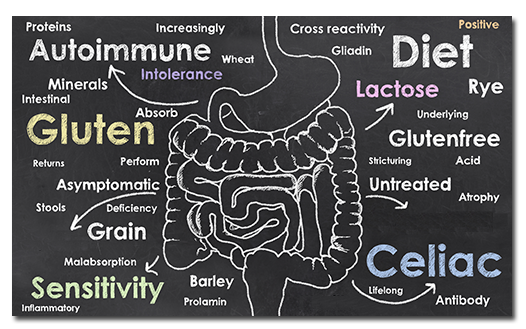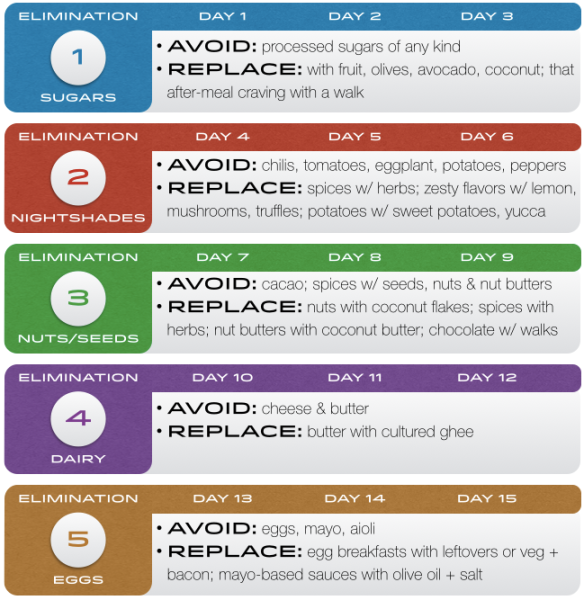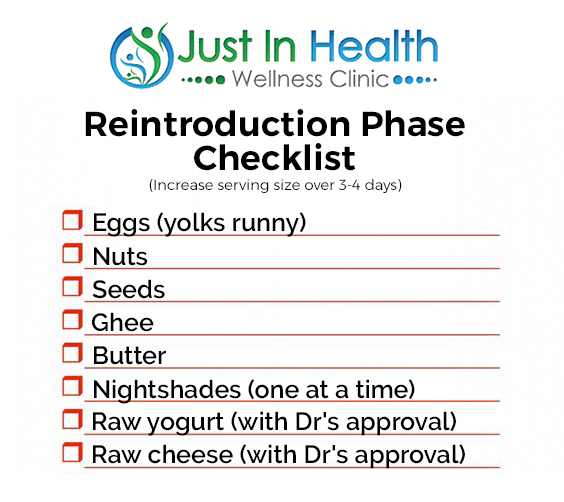
By Dr. Justin Marchegiani
Elimination diets can be a very effective way to address autoimmunity issues, leaky gut, and inflammation and can optimize overall health. But you have to know where to start and what to eliminate, and that can seem like a daunting task. An elimination diet simply means cutting out certain foods that irritate your body or that don’t promote your health. While it may initially take some work to separate the gems (good foods) from the slag (bad foods), it is important to nail down foods that aren’t beneficial to your body and eliminate them!
There are many different kinds of elimination diets, and what makes it tricky is the fact that everyone’s body is different. What works for someone else may not work for you, and vice versa, so dairy may be the trigger food that irritates your autoimmune condition while it doesn’t impact your friend’s autoimmunity at all. The key will be to eliminate the trigger foods specific to you.
My goal is to help you mine those gems that lead to a successful elimination diet that will improve your autoimmunity, leaky gut, inflammation, and overall health. Specifically, we’ll talk about elimination diets and the digestive and immune systems’ responses to food, what foods to eliminate, and how and when to reintroduce foods to your diet.
The Paleo diet, or Paleo template as I like to call it, is a common elimination diet, and most people are at least familiar with the name. What’s a Paleo diet? The general idea is to cut any food that wouldn’t have been consumed by humans during the Paleolithic Era. So we would cut things like grains, legumes, peanuts, alcohol, dairy, sugar, and all processed foods. There are many versions of a modern Paleo diet, and some may even cut higher carbohydrate fruits, like bananas and mangoes. Some versions of this diet allow for butter. Generally speaking though, it’s a real-food diet. So anything that’s not real is eliminated from the diet.
The autoimmune template takes us one step farther. We can even talk about things like a specific carbohydrate diet or Gut and Psychology Syndrome (GAPS) diet when discussing an autoimmune diet. In an autoimmune diet, we may also cut out eggs, nightshade vegetables (tomatoes, potatoes, eggplants, peppers—TPEP for short), nuts, and seeds. So it’s more extreme than a basic Paleo diet, and someone on a Paleo diet may be able to tolerate these foods without a problem.
Find out more about elimination diet by consulting with a functional medicine doctor.

Food allergies start with the inability to break down food. So people who have an autoimmune condition tend to have a lot of digestive issues. In autoimmunity, if we’re not able to break down foods (e.g., protein not broken down into amino acids or fats not broken down into their fatty acid constituents), food particles stay larger. Those large food particles can slip through the gastrointestinal wall, especially in a leaky gut (where the tight junctions of the gastrointestinal wall separate, allowing the contents of the gut to leak unfiltered into the bloodstream), and into the bloodstream.
The immune system detects these rogue food molecules as invaders and hyper-responds, attacking the large particles. From there the confused immune system may also attack other tissues, like the thyroid gland or the brain, because they look similar to the larger food molecules (called mimicry); this is the force behind an autoimmune condition.
In transitioning to an autoimmune diet, things like hydrochloric acid (HCl), enzymes, and bile support may be very helpful in breaking down foods so we can properly digest them and absorb their nutrients. We’re going to shift from our unhealthy autoimmune response to food and start to develop a healthy new response to food.
Before we move into what you should eliminate, let’s cover what foods you can eat on these elimination diets. Most people should begin on an autoimmune-Paleo template. Foods you typically can eat on this template include the following:
So let’s say you’re my patient right now, and we’re seeing some autoimmune tendencies, such as inflammation. I’m going to set you up on the autoimmune template and have you cut out nuts, seeds, nightshades, and eggs for three or four weeks—until I see some kind of improvement. Typically, these could be digestive improvements in bloating, gas, stool consistency, or frequency of bowel movements. We could see less fatigue and less brain fog or improvements in hormones, thyroid function, energy, and weight loss. When we start to see symptoms improve, that’s a signal we can move to the next step, which will be to slowly reintroduce foods one at a time so we can determine what foods are driving your autoimmunity.

The reintroduction phase is typically a 2 to 3 days day period (4 days for more sensitive patients). On day one, we might start with just one bite of a tomato or salsa. Then on day two or three, we may eat a whole tomato. The basic structure is to start with one very small serving (one scoop, one teaspoon, etc.) and increase the serving size over that three- to four-day period, seeing if we can tolerate it.
Start adding back foods after it's been at least 4 weeks and your symptomatic improvement has plateaued for at-least 1 week. In other words the improvement you may of felt initially while starting has flat-lined. It's important to make sure your symptoms are relatively stable before you start reintroducing foods. This way you know if it is the new food causing the problem and not some other unknown variable. Many people continue to improve on the diet past 4 weeks so we don't want to cut off those gains by reintroducing foods too soon.
The idea here is that if you have a negative response to the food you are reintroducing, it will be size-dependent. The smaller the food, the smaller the response; the larger the food, the larger the response. So if you’re prone to having joint pain or brain fog or energy dips, a smaller reintroduction gives you less-intense symptoms. So watch for those negative symptoms. What could those symptoms be? It could be joint pain, fatigue, brain fog, weight gain, and symptom you might have typically experienced prior to your diet.
It could simply be that it’s too soon to add that food back in, and after your gut has healed more, you can try it again.
First, add eggs. Keep the yolks runny. Why? The egg yolks tend to rancidify and denature when they’re cooked too much. So ixnay on the scrambled eggs; keep it to poached eggs or sunny-side up or over-easy. The litmus test is, the yolks must run when you poke them. Down the road, when you are healthier, you can splurge on an occasional omelet, but don’t make it a habit. You don’t want your body to hyper-respond to the potential denatured protein in the yolks.
Third, add dairy. What kinds of dairy? Ghee, clarified butter, is a good choice here. The whey protein, the casein, and the lactose is typically pulled out, so you just have the butterfat in the ghee, which makes it a bit more hypoallergenic. A lot of people on an autoimmune diet may not be able to handle any dairy but ghee. After ghee, you can add the following in this precise order:
Why cheese before milk? Because cheese is cultured in a way where there is typically less lactose.
Second, add nuts and seeds (one at a time only). Try to keep them to soaked nuts. The soaked nuts will be better because you’ll be deactivating some of the phytates and lectins. Some of the antinutrients that are in those foods will be deactivated by soaking them.
Fourth, add nightshades. What’s the problem with nightshades? They fall into a family that has a high amount of compounds known as alpha-solanines and glycoalkaloids. These can be irritating compounds. They can get into the joint tissue and create inflammation. They can be particularly irritating for people who have arthritis or joint pain. Nightshades can also cause skin issues, fatigue, brain fog, weight gain, hormone issues, and so on. If you’re just not quite feeling right, any intensification of symptoms, keep an eye on the nightshades.
FODMAP foods can be added back in after AIP foods have been added back in. If you weren't asked to removed higher FODMAPS you can ignore this step. If you did pull higher and moderate FODMAP foods out of your diet you can start with your favorite moderate FODMAPS following the same protocol above. Once you have maxed out your moderate FODMAP options you can start working in the high FODMAP food options. Any negative symptoms you can remove the foods from your diet and try again next month. You can click here to access Dr. J's fodmap handout.

1. Go on a Paleo template or elimination diet (no grains, legumes, dairy, peanuts, alcohol, and packaged processed food).
2. Eat good, clean meats, preferably healthy and organic.
3. Consume good, clean fats and carbohydrates primarily from non-starchy vegetables or safe starches, such as squash, plantains, sweet potatoes, jicama, and yuca.
4. Eat low-sugar, low-glycemic fruits, like green apple, berries, lemon, lime, raspberries, strawberries, and grapefruit.
5. Avoid eggs.
6. Cut out nightshade vegetables (TPEP, or tomatoes, potatoes, eggplants, and peppers).
7. Avoid nuts and seeds.
8. Wait about three to four weeks, and then reintroduce foods slowly during a three- to four-day period.
9. Start with small bites, and increase to bigger servings.
My goal is for you to have a good understanding of how to eliminate foods and reintroduce foods accordingly and to make sure you’re properly digesting the foods you’re adding back in. If you have a deeper issue where there’s maybe adrenal dysfunction or a gut infection, like a leaky gut from a parasite, fungal overgrowth, small intestinal bowel obstruction (SIBO), or dysbiotic infection, reach out if you need help getting to the root issue and developing a good treatment of care to get back on your feet again.
Click here to get professional advice on diet issues from a functional medicine doctor.